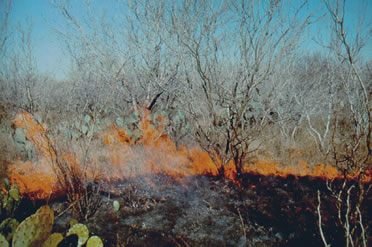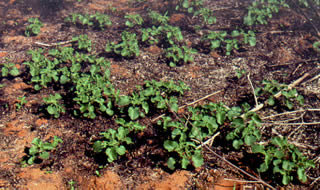South Texas Plains Habitat Prescribed Burning (Fire)

Prescribed burning in the brush country. Photo by TPWD staff biologists.
South Texas habitats evolved through fire. However, fires are not all alike. Prescribed fires are also known as controlled burns because they control some plants and encourage the growth of others. Historically, natural and man-caused fires occurred frequently. Biologists now use fire to manipulate vegetation for the benefit of wildlife. A prescribed burning program, in conjunction with grazing deferment and deer harvest management, is an effective tool for managing wildlife habitat. List below are some general benefits of prescribed burning.
- Enhances habitat diversity by increasing plant quality/vigor & increases the quantity of wildlife foods (forbs) by suppressing non-native grasses.
- Increases nutrient cycling by fixing nitrogen in the soil from burn debris, thereby having a fertilization effect on the range.
- Increases moisture filtration into the soil.
- Controls invasive vegetation which is not fire tolerant such as juniper in the Edwards Plateau or Lehmann's Lovegrass in South Texas.
- Opens vegetative overstory to allow light penetration to the soil surface for forb and browse production.
There is an art and a science to using this powerful tool. Fires can be cool or hot. Depending upon weather conditions and management practices before and after the burn, various plants can be selected for or against. Cool fires seldom harm mature trees while hot fires can top-kill trees. A late winter/early spring (before green-up) burning schedule gives priority to ensure the most productive results for wildlife. Even with the best planning, however, windows of opportunity always depend on humidity,wind, and fuel moisture. Landowners/land managers are encouraged to learn how to use prescribed fire by first assisting on a planned controlled burn before attempting one on their own. They should contact professionals with Texas Parks & Wildlife, Natural Resource Conservation Service, or the Texas A&M Extension Service.

Ground cherry respond favorably to fire. Photo by TPWD staff biologists.
For more information on prescribed burning, please see Prescribed Range Buring in Texas (PDF 362.1 KB).
(PDF 362.1 KB).
Prescribed fires improve habitat quality. Notice the forb response to a fire in the photo below. The forbs provide great food resources for wildlife.